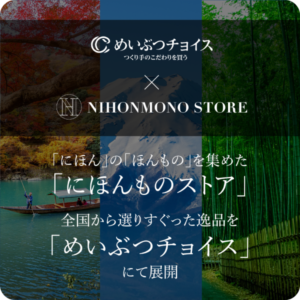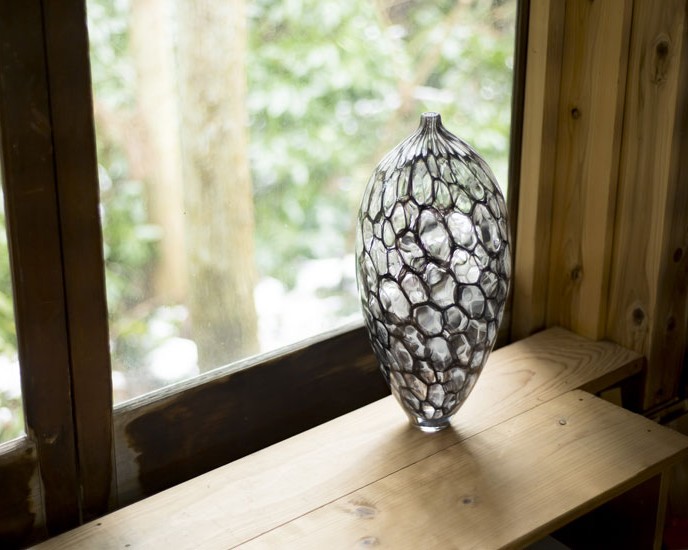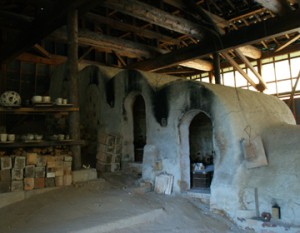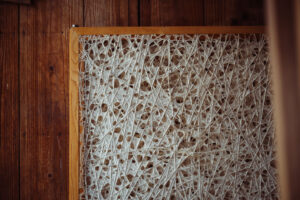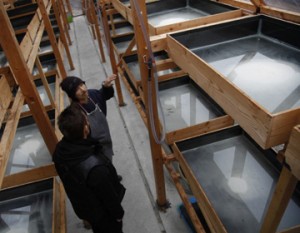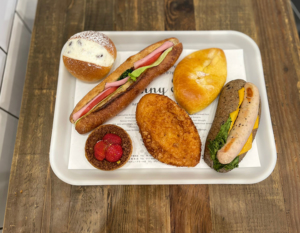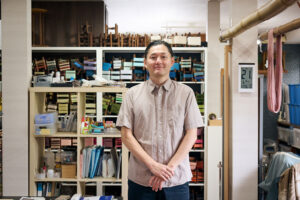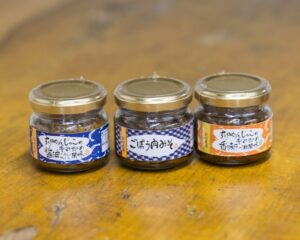The moment when molten glass releases a beautiful glow. Blown glass is a craft that captures that moment. Kota Arinaga encapsulates the long hours spent in the textile process in blown glass, which could be called “the beauty of the moment”. He has a studio on Notojima Island in Nanao Bay, and we will touch on his thoughts as he expresses his own worldview based on the Venetian glass technique.
A beautiful world of glass, woven with fine fibers

The irregularly shaped, bubbly pattern looks as if it might start moving at any moment. The play of light and shadow is breathtaking. It seems as if life has taken up residence in glass, which is normally considered to be an inorganic material. If you look closely, you can see the fine fibers in each bubble. It looks more like a coarse-textured knitted fabric than a bubble.
Inspired by the technique of “lace glass”, a traditional Italian glass craft known as Venetian glass, glass artist Kota Arinaga created “netz” using his own unique techniques. This series of works, which means “net”, has become synonymous with Arinaga, along with his “gaze” series, which is inspired by textiles.
Glass and textiles. Incorporating the flow of opposing time into his works

When you hear the phrase “textile-inspired”, you might be a little puzzled. Textiles are made by spinning thread and weaving it together over time, crossing the warp and weft threads. On the other hand, blown glass, which must be shaped before it cools and hardens, is a race against time. The processes of glass and textiles seem to be completely opposite.
Mr. Arinaga says, “I wanted to capture the time axis of the textile process, which involves a huge number of steps, in the ‘instant’ of blown glass.” This series of works is also created through a precise and laborious process of stretching glass like twisting thread. When the time axis of glass and textiles overlap, the work takes on a deep sense of depth.
Arranging the technique of Venetian glass in a Japanese aesthetic sense
Venetian glass is characterized by its sophisticated, perfect forms and regular designs, but Arinaga’s works have movement, distortion and a unique expression. Rather than recreating Venetian glass, he aims to “reconstruct this technique with a Japanese sense of beauty and aesthetics”.
The Japanese aesthetic sense is unique in that it finds natural beauty in imperfection. Arinaga uses highly advanced techniques that are precisely calculated to express this “beauty of irregularity”.
Making everyday tableware in a studio on Notojima Island, where you can feel the changing of the seasons

Notojima, in Nanao City, Ishikawa Prefecture, where the studio is located, is a place where you can feel the changing of the four seasons. Surrounded by light and greenery, Mr. Arinaga makes dozens of vessels every day. He says that he makes vessels over and over again, and that he creates his own form by letting the movement become ingrained in his body.

For Mr. Arinaga, both the large, one-of-a-kind works that require delicate techniques and the everyday vessels are on the same line of craftsmanship.
“Techniques and skills are tools for expression. That’s why you have to keep looking after them and polishing them, and you have to keep using them or they won’t improve.” He keeps his hands busy making everyday vessels, polishing up his skills and bringing out his own style. Mr. Arinaga’s style of production is artisan-like and stoic.
Vessels that enrich the hearts and lives of their users

While making pottery on a daily basis, Mr. Arinaga thinks about and tries out various things as he works. For example, he has a set of sake cups with different shapes. The wide-mouthed flat cups have a shape that makes the rim and tongue of the cup almost parallel, so that the liquid stops at the tip of the tongue, making it easy to taste the sweetness and bitterness. The small-mouthed guinomi cups are said to make it possible to enjoy a clean taste. On the other hand, the narrow-mouthed kouhai cups are designed so that the liquid flows easily into the mouth. This allows the sake to spread out horizontally, making the flavor more intense. The narrow opening also means that the aftertaste can be enjoyed for longer.
The person who gave me the idea was the owner of a local izakaya. He told me about it when he found out I was working with glass. He said, ‘I never realized that the shape of a sake cup could make such a difference to the taste of the sake. The owner of the izakaya explained to Mr. Arinaga at great length, and he laughs wryly, saying, “I didn’t taste the sake at all at the time. He says that when he was making the vessels, he suddenly remembered the izakaya, and he tried to make sake vessels that would allow him to experience that.
He hopes that the vessels he makes will be easy to use and enrich people’s lives. The vessels he creates with this wish in mind add color and small discoveries to the lives of the people who use them.
In the extraordinary circumstances that followed the earthquake, his hands stopped making vessels.

The Noto Peninsula earthquake that struck on January 1st 2024 also caused damage to the pottery workshop on Notojima Island. The kiln, which weighed 800kg, moved around a lot and cracked the floor, and most of the works were broken. Many of the solo exhibitions planned for that year had to be cancelled, and the shock was great.
“If I don’t make anything, I won’t have any income, so I have to make something,” he said, and he worked to restore his studio, but he says that he felt impatient as the extraordinary situation continued day after day. The damage to the area was so great that he also felt unsure about whether it was okay for him to start working again.
At that time, he received a message from a gallery owner he knew well, who said, ‘Go ahead and make things. I’ll make sure to sell them.’ Hearing this, he was able to look forward again, thinking, ‘It’s okay to start making things again.’
The beautiful blue color was born from the broken glass fragments.

All the broken pieces were melted together and remade into a new piece. The colors of the fragments were different, but the color that was born from mixing them together was a soft blue. It was a color that reminded one of the sea of Noto, and so it was named “0101 (zero-one-zero-one) blue”, after the date of the earthquake.
For the first year after the disaster, he struggled to get back into the rhythm of his creative activities, but when he crossed over that time on January 1st the following year, he says, “I thought to myself that it was only natural that my pace and style of work would change, given the terrible things that had happened.” When he accepted the change, he says he suddenly felt a weight lift from his shoulders.
Developing a compact next-generation kiln

Alongside his creative work, Arinaga is also involved in something else: expanding the scope of the glass industry.
It is a high hurdle to become an independent glass artist. One of the reasons for this is the kiln. Once the kiln is fired up, it is not possible to stop it. If the fire is turned off, the crucible used to melt the glass has to be replaced, and when the temperature is raised again, it takes extra time and fuel. You can’t be away for long periods of time either, to maintain the kiln with the fire still burning.
Mr. Arinaga thought, “If only there was a kiln that was more compact, easier to control, and had more flexibility”, and he took his idea to the kiln manufacturer, who developed a kiln that could be turned off when not in use.
I want to be a model that expands the possibilities of blown glass.

If the number of potters decreases, there will be fewer people making kilns, crucibles and tools. If the entire glass industry comes to a standstill, “everyone will be in trouble, and I will be in trouble too,” says Mr. Arinaga. If there were kilns that were easy to use when starting out as an artist, it might be possible to increase the number of potters. In fact, the introduction of “Arinaga-style” kilns is spreading, especially among young artists, and improvements are being made.

Every day he faces the glass in the “Arinaga-style” kiln that he helped to develop. His desire to expand the scope of his work grows stronger, “I want people to know that this kiln can create such expressions”.
He spins and weaves glass threads. It seems that the time that Mr. Arinaga has encapsulated in his glass also includes time that leads to the future.
